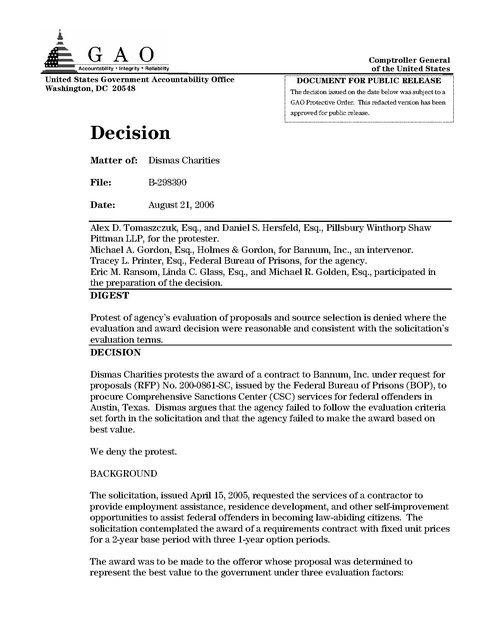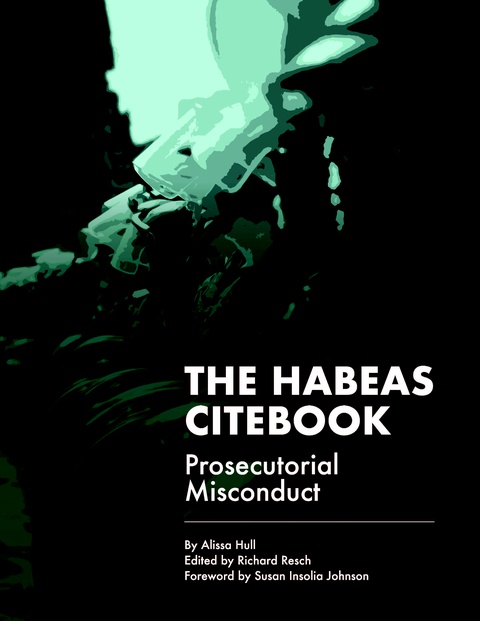Gao Decision Dismas Charities Aug 21 2006
Download original document:

Document text

Document text
This text is machine-read, and may contain errors. Check the original document to verify accuracy.
United States Government Accountability Office Washington, DC 20548 Comptroller General of the United States DOCUMENT FOR PUBLIC RELEASE The decision issued on the date below was subject to a GAO Protective Order. This redacted version has been approved for public release. Decision Matter of: Dismas Charities File: B-298390 Date: August 21, 2006 Alex D. Tomaszczuk, Esq., and Daniel S. Hersfeld, Esq., Pillsbury Winthorp Shaw Pittman LLP, for the protester. Michael A. Gordon, Esq., Holmes & Gordon, for Bannum, Inc., an intervenor. Tracey L. Printer, Esq., Federal Bureau of Prisons, for the agency. Eric M. Ransom, Linda C. Glass, Esq., and Michael R. Golden, Esq., participated in the preparation of the decision. DIGEST Protest of agency’s evaluation of proposals and source selection is denied where the evaluation and award decision were reasonable and consistent with the solicitation’s evaluation terms. DECISION Dismas Charities protests the award of a contract to Bannum, Inc. under request for proposals (RFP) No. 200-0861-SC, issued by the Federal Bureau of Prisons (BOP), to procure Comprehensive Sanctions Center (CSC) services for federal offenders in Austin, Texas. Dismas argues that the agency failed to follow the evaluation criteria set forth in the solicitation and that the agency failed to make the award based on best value. We deny the protest. BACKGROUND The solicitation, issued April 15, 2005, requested the services of a contractor to provide employment assistance, residence development, and other self-improvement opportunities to assist federal offenders in becoming law-abiding citizens. The solicitation contemplated the award of a requirements contract with fixed unit prices for a 2-year base period with three 1-year option periods. The award was to be made to the offeror whose proposal was determined to represent the best value to the government under three evaluation factors: technical/management, past performance, and price. The solicitation stated that the technical/management and past performance evaluation factors, when combined, were “significantly more important than price,” and that of the two non-price evaluation factors, “past performance is more important.” Solicitation § M.5, Agency Report, Tab 1. However, the solicitation also advised that price, though of lesser importance than the technical/management and past performance evaluation factors, could contribute substantially to the award decision. Id. A source selection evaluation board (SSEB) was to evaluate the offerors’ proposals in the technical/management area using a color/adjectival rating system: blue/very good; green/acceptable; yellow/poor; and red/unacceptable. Id. § M.3, M.5. The contracting officer (CO) was to evaluate the offerors’ proposals in the past performance area using the same color/adjectival system. Id. § M.5, 1.0. Timely proposals were received from three offerors, including Dismas and Bannum. After an initial review, the SSEB determined that none of the proposals met the solicitation’s minimum requirements and the agency therefore conducted two rounds of written discussions. After discussions, Dismas’s revised proposal received a blue/very good rating in the technical/management area, a blue/very good rating in the past performance area, and offered an evaluated price of $[DELETED]. Bannum’s revised proposal received a green/acceptable rating in the technical/management area, a blue/very good rating in the past performance area, and offered an evaluated price of $[DELETED]. The third offeror’s revised proposal received a green/acceptable rating in the technical/management area, a blue/very good rating in the past performance area, and offered an evaluated price of $[DELETED]. The CO reviewed the SSEB’s evaluation and independently considered the subfactor strengths and weaknesses that contributed to each proposal’s overall color/adjectival ratings. The CO noted that Dismas’s technical/management proposal was rated higher than the other proposals, but also that all three proposals met the minimum solicitation requirements and represented a low risk to the government. After evaluating the ratings, risk factors and price, the CO determined that, “from the business point of view, the value of Dismas’s program (non-cost factor) did not warrant payment of a premium of $[DELETED] over the lowest priced offeror.” Agency Report, Tab 13, at 13. The CO then selected Bannum’s proposal as the best value to the government. The agency notified the other offerors that Bannum had been selected for the award on March 28, 2006, and Dismas submitted a written request for debriefing on March 29, 2006. The agency provided Dismas with a written debriefing on May 31, 2006 and Dismas filed its protest with our Office on June 5, 2006. Dismas raises three bases of protest. First, Dismas alleges that the agency failed to follow the evaluation criteria with regard to Bannum’s technical/management evaluation and that Bannum’s proposal failed to meet the minimum technical/management requirements of the solicitation. Second, Dismas alleges that Page 2 B-298390 the agency improperly evaluated Bannum’s past performance by overlooking outside negative past performance information that Dismas maintains was “too close at hand” to ignore. Third, Dismas alleges that the agency conducted a flawed best value determination by turning a “best value” procurement into a “lowest-cost technically acceptable” procurement. DISCUSSION With regard to Dismas’s allegation that the agency failed to follow the evaluation criteria in evaluating Bannum’s technical proposal, Dismas specifically alleges that the proposal failed to meet two solicitation requirements. First, Dismas argues that Bannum’s zoning documentation was not legally valid and could not meet the solicitation requirements regarding zoning and ordinance approvals. Second, Dismas argues that Bannum’s proposed site location did not meet the solicitation’s minimum requirement for parking spaces. We find no merit in Dismas’s allegations. Initially, we point out that in reviewing protests of allegedly improper evaluations, our Office will not substitute its judgment for that of the contracting agency, but rather will examine the record to determine whether the agency’s judgment was reasonable and in accord with stated evaluation criteria, and whether there were any violations of procurement statutes and regulations. Norfolk Ship Sys., Inc., B-219404, Sept. 19, 1985, 85-2 CPD ¶ 309. The solicitation required offerors to “submit official documentation that demonstrates . . . an approval or plan to obtain zoning and/or an occupancy permit for their proposed site.” Solicitation Section J, Agency Report, Tab 1. In the event that discussions were conducted, as was the case here, the solicitation further required offerors to “provide the Contracting Officer with valid proof of all zoning and local ordinance requirements necessary for the operation of [the proposed CSC].” Id. Bannum included in its proposal an approved certificate of occupancy (COO) for its proposed site location which stated that there was “no limit for the number of residents . . . for transitional housing for halfway houses for adult offenders making the transition from institutional to community living.” Agency Report at 6-7; Agency Report, Tab 7. The COO was provided to Bannum by the city of Austin as establishing the zoning for the site location at issue. Intervenor’s Comments at 1. Each agency technical panelist reviewed the COO and accepted it as meeting the solicitation requirements for zoning and ordinance approvals. Agency Report, Tab 17. We agree with the agency that the COO that was provided by the city of Austin and included in Bannum’s initial proposal met the solicitation requirements to “submit Page 3 B-298390 official documentation that demonstrates an approval or plan to obtain zoning 1 and/or an occupancy permit.” In this regard, Bannum’s initial proposal provided the agency with proof of zoning when discussions began, and the agency had no reason to require further documentation. Given the solicitation’s requirements and the nature of this particular COO, the agency acted reasonably in accepting the COO. We therefore deny this basis of protest.2 Dismas’s other technical evaluation argument, that Bannum’s proposed facility failed to meet the solicitation’s minimum requirement for parking spaces, is also without merit. To support its allegation Dismas relies on a statement in the source selection decision (SSD) that “[o]ther than the parking issue, [Bannum’s proposal] met the minimum requirements of the solicitation.” Agency Report, Tab 13, at 9. The agency responds that Dismas’s interpretation of the SSD is unreasonable because the solicitation itself contained no requirement for a particular number of parking spaces. While the source selection authority (SSA) may have used a poor choice of words, the record does not support the view that Bannum failed to meet a minimum requirement for a certain number of parking spaces. The solicitation did not include a requirement for a particular number of parking spaces within the statement of work or any other section. The solicitation simply required each offeror to submit a legible and accurate floor plan for the proposed facility, showing “the location buildings, roads, fences, parking lots, walkways, and adjacent buildings.” Solicitation Statement of Work, Ch. 3, at 25, Agency Report, Tab 1. It is clear from the technical evaluation of Bannum’s proposal that the proposed site’s six parking spaces were noted as a weakness, not as a failure to meet the solicitation’s minimum 1 The COO authorized not only occupancy but also a specific use, transitional housing. As the intervenor points out, the Austin City Code provides that a COO may not be issued unless the development has been completed “in accordance with the released site plan, construction plans, and other ordinance requirements.” Austin City Code § 25-1-363; Intervenor’s Comments at 2. Where, as here, the COO contained approval of the given use, we believe the agency was reasonable in accepting it as proof of the required approvals. 2 Dismas also argues that the agency had an obligation to further assess the legality of Bannum’s COO, and has presented evidence that the present owner of Bannum’s proposed site location applied for additional zoning approvals during the evaluation process. Dismas has not, however, presented evidence to demonstrate that the tendered COO was revoked at any point during the evaluation, nor does the record indicate that the COO was otherwise invalid. Where, as here, the solicitation required offerors to submit official documentation demonstrating an approval or plan to obtain zoning and/or an occupancy permit, the agency’s reliance on the COO submitted by Bannum was reasonable and sufficient. Page 4 B-298390 requirements. Agency Report, Tab 16, at 3. It is also clear that the SSD itself referred to the parking issue as “one weakness that was not significant,” and further stated that all proposals met the minimum requirements. Agency Report, Tab 16, at 3; Tab 13, at 13. Accordingly, this basis of protest is denied. With regard to the past performance evaluation, Dismas alleges that the agency improperly ignored Bannum’s negative performance on a previous contract with the BOP. The solicitation required each offeror to submit “the 5 most relevant contracts and/or subcontracts that were, or are currently being, performed in the past 3 years.” Solicitation § L.8; Section J. Dismas’s allegation does not involve negative performance on a contract submitted for evaluation in Bannum’s proposal. Rather, Dismas references a Court of Federal Claims protest decision, Bannum, Inc. v. United States, 69 Fed Cl. 311 (2006), in which the Court makes reference to Bannum’s performance of a prior contract during which Bannum “fail[ed] to alert the BOP of an escaped prisoner in a timely manner.”3 69 Fed. Cl. at 316; Protest at 11. Dismas argues that, in light of the negative past performance information referenced by the Court in Bannum, it was unreasonable for the agency to rate Bannum’s past performance as blue/very good, asserting that the past performance information referenced in the court decision was “too close at hand” for the agency to ignore.4 Protest at 11. An agency’s past performance evaluation is a matter within its discretion and we will not question it unless it is unreasonable or inconsistent with the terms of the solicitation or applicable statutes and regulations. Continental RPVs, B-292768.2, B-292768.3, Dec.11, 2003, 2004 CPD ¶ 56. There is no legal requirement that all past performance, or even all past performance references listed in an offeror’s proposal, be checked or included in a valid review of past performance. See Dragon Servs., Inc., B-255354, Feb. 25, 1994, 94-1 CPD ¶ 151 at 8; Questech, Inc., B-236028, Nov. 1, 1989, 89-2 CPD ¶ 407 at 3. What is critical is whether the evaluation is conducted fairly, reasonably, and in accordance with the stated evaluation criteria, and whether it is based upon relevant information sufficient to make a reasonable determination of the offeror’s overall past performance rating, including relevant information close at hand or known by the contracting personnel awarding the contract. See, e.g., International Bus. Sys., Inc., B-275554, Mar. 3, 1997, 97-1 CPD ¶ 114 at 5. At the outset, we note that the negative past performance discussed by the Court in Bannum appears to have taken place prior to the period contemplated by the 3 The past performance information referenced by the Court in Bannum had been provided by Bannum in response to three solicitations, which had been issued on April 29, 2002, January 2, 2002, and August 6, 2001, respectively. 4 Here, one of the COs in this procurement, Rebecca Canfield, was also the CO in the Hattiesburg, Mississippi contract involved in Bannum, Inc. v. United States. Page 5 B-298390 solicitation for consideration of past performance activity. As discussed above, the solicitation required each offeror to submit “the 5 most relevant contracts and/or subcontracts that were, or are currently being, performed in the past 3 years.” Solicitation § L.8; Section J. As also noted above, the negative past performance information discussed by the Court, on which Dismas’s protest relies, was identified in connection with the agency’s evaluation of Bannum’s responses to three prior solicitations, the latest of which was issued on April 29, 2002—almost exactly three years prior to issuance of the April 15, 2005 solicitation at issue here. Accordingly, although the record does not precisely establish when the negative past performance occurred, it strongly suggests that the past performance discussed by the Court in Bannum, on which Dismas’s protest relies, occurred prior to the 3-year period contemplated by the solicitation for consideration. In any event, Bannum provided five contracts which met the solicitation requirement for recent and relevant past performance information. Agency Report, Tab 18. Dismas has not questioned the agency’s past performance evaluation with regard to those five contracts. In evaluating Bannum’s proposal, the agency considered certain prisoner accountability issues similar to those discussed in the court decision, but nonetheless determined that Bannum’s past performance was properly rated blue/very good. Agency Report, Tab 18, at 7. Accordingly, even if the record were to establish that the negative past performance information discussed by the Court in Bannum took place during the period contemplated by the solicitation, and even if we were to conclude that this information was “too close at hand” for the agency to ignore, the record does not support Dismas’s assertion that it was unreasonable for the agency to rate Bannum’s past performance as blue/very good. Accordingly, we find no basis to sustain Dismas’s protest challenging the agency’s past performance evaluation. Finally, Dismas alleges that the agency failed to make the award in accordance with the best value methodology identified in the RFP. Dismas alleges that the CO gave more weight to price than to the technical evaluation factors, ignoring the solicitation and converting this best value procurement into a lowest cost/technically acceptable procurement. In support of its allegation, Dismas points to its debriefing letter, in which the CO stated that “[t]here were no tradeoffs used in determining the award of the contract” to Bannum. Protest, Exh. 3, at 3. Dismas takes this statement to mean that the agency did not consider awarding the contract to a higher priced, but technically superior offeror and simply awarded the contract to the lowest priced acceptable offeror. We disagree with Dismas’s assertion. Where a solicitation provides for award on a best value basis, it is the function of the SSA to determine whether one proposal’s technical superiority is worth a higher price and that decision is governed only by the test of rationality and consistency with the stated evaluation criteria. See Chenega Technical Prods., LLC, B-295451.5, June 22, 2005, 2005 CPD ¶ 123 at 8; Leach Mgmt. Consulting Corp., B-292493.2, Oct. 3, 2003, 2003 CPD ¶ 175 at 3-4. The agency has “broad discretion in determining the manner and extent to which [it] will make use of the technical and price evaluation Page 6 B-298390 results in making price/technical tradeoffs.” Property Analysts, Inc., B-277266, Sept. 12, 1997, 97-2 CPD ¶ 77 at 6. An agency may “properly award to a lower rated, lower cost offeror, even if cost is the least important evaluation factor, if it reasonably determines that award to the higher cost offeror is not justified given the level of technical competence available at the lower cost.” Id. Notwithstanding the information in the debriefing letter suggesting that no tradeoff was made, the SSA provided a well-documented SSD that demonstrated a detailed comparison of each offeror’s strengths and weaknesses and a rationale for the best value award to Bannum. Agency Report, Tab 13, at 8-12. The SSA substantiated the SSEB’s ratings and risk assessments and acknowledged that Dismas received a higher technical/management rating than the other offerors. Id. The SSA then considered the price premium of an award to Dismas and determined that Dismas’s higher rated proposal was not worth the additional cost of $[DELETED]. Id. at 13. Accordingly, the contracting officer did, in fact, make a tradeoff between Dismas’s higher technical/management rating and Bannum’s lower evaluated price, properly adhering to the solicitation’s stated best value award basis. The protest is denied. Gary L. Kepplinger General Counsel Page 7 B-298390





